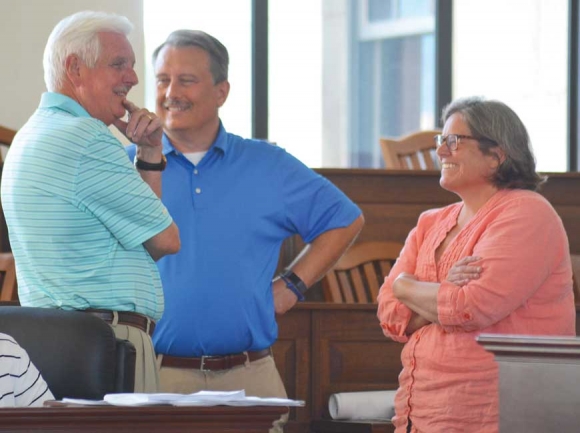Plott Creek site plan OK’d
 Waynesville Planning Board Vice Chairman Danny Wingate (left to right), Chairman Patrick McDowell and Development Services Director Elizabeth Teague chat before a meeting July 30. Cory Vaillancourt photo.
Waynesville Planning Board Vice Chairman Danny Wingate (left to right), Chairman Patrick McDowell and Development Services Director Elizabeth Teague chat before a meeting July 30. Cory Vaillancourt photo.
The site plan submitted by developers for a controversial 200-unit apartment complex off Plott Creek Road was approved by the Town of Waynesville Planning Board July 30, but not before a marathon meeting that dragged on for more than six hours and threatened to stretch into the next day.
Right off the bat, attorney Craig Justus set the tone for the hearing by challenging the threshold of standing required in the quasi-judicial proceeding. Representing Alexandria, Virginia, resident Patricia Plott Edwards, after whose family the area and creek are named, Justus’ opening shots were indicative of how the 5:30 p.m. hearing would transpire.
“As a representative of the Plott family and with considerable knowledge of properties along Plott Creek Road, I believe the apartment complex would have a substantial impact on the value of our family’s land,” said Edwards.
The role of the nine-member Planning Board during the hearing, Chairman Patrick McDowell explained, was to determine whether or not the plan met five important criteria: that the plan is consistent with adopted plans and policies of the town; that it complies with all applicable requirements of the ordinance; that transportation and utility infrastructure can adequately support the plan; that the plan conforms to the character of the neighborhood with type and height of buildings and landscaping; and that the project would not substantially injure the value of the adjoining properties.
Waynesville Development Services Director Elizabeth Teague read into the record a staff report opining that all five criteria had been met.
Indeed, Teague presented similar findings to the planning board May 21 in support of a text amendment necessary for the development; the board voted in favor of recommending the amendment to aldermen but for the dissent of Ginger Hain and Jason Rogers.
Related Items
The next day, the Waynesville Board of Aldermen accepted that recommendation by a vote of 4 to 1, with only Alderman Jon Feichter dissenting.
Although those votes cleared the way for developers to proceed — and drew overflow crowds to the meetings — Waynesville Mayor Gavin Brown told opponents they’d again have a chance to make their wishes known during the site plan review.
After Teague’s presentation, Justus questioned her for an more than an hour in an exchange that turned testy at times as he tried to trip her up with procedural technicalities that hold little relevance to the crux of the development itself.
First, he grilled her on the requirements of an application for site review, and then on why a sewer and water plan hadn’t been submitted with the site plan. Then he asked her what the definition of a site plan actually was, and contested her definition.
Next, the two sparred over the validity of the development’s required civic space; Justus contended that the 2.1-acre threshold hadn’t been met, despite the developer’s plan to leave 21 of the 41 acres on the parcel in their natural wooded state.
He was rebuffed at practically every turn with some planning board members sharing exasperated smirks as the meeting stretched into its third hour.
Then, speaking for the developer, William Ratchford of Gastonia-based Triangle Real Estate Company got the opportunity to make his case, bringing with him a host of experts.
Tom Jones with WGLA Engineering testified on infrastructure. Mark Teague of J.M. Teague Engineering testified on traffic. Rick Merrill, a Beverly-Hanks broker from Hendersonville said this was the fifth site he’d sold the company.
“In the other four sites that I sold them, those sites are fully built out and all the properties that adjoin those sites have gone up in value since the completion of those apartments,” Merrill said.
As the meeting entered its fourth hour, the initial crowd of about 60 — less than the number of people who’d attended the back-to-back meetings in May — had dwindled to about 30.
Justus then crossed-examined Jones, challenging him on the development’s driveway, badgering him to the point that Town Attorney Bill Cannon objected, causing Justus to abandon the line of questioning. Justus then asked where the development would get water from, since his client had refused to allow her property to be used for routing pipes.
Property appraiser John Palmer, of Buncombe County, was then called by Justus to testify to the impact the project would have on a large multi-million dollar home just to the west.
“In my opinion, the proposed apartment complex would substantially injure the parcel,” Palmer said.
Teague mentioned that while Palmer had obviously looked at the 15,800 square-foot estate down the road, he hadn’t looked at the properties to the east, towards downtown Hazelwood. Would those property values decline, too?
“No, I don’t think they would,” he said.
Almost five hours into the meeting, the public comment session began; only one person who hadn’t already spoken signed up — attorney Chuck Dickson, an adamant opponent of the development throughout the process who lives within sight of it.
Dickson reiterated previous arguments, even going so far as to draw on the name of the proposed development, The Palisades at Plott Creek.
“The name of this project does not represent community,” he said, noting that the word “palisade” means fence or barrier. “It is an enclave.”
The proceedings then moved into closing arguments, where Justus impugned Teague by saying that in his 30 years of practicing law, he’d “never seen a town staff so adamant about a set of plans.”
Teague’s job is to represent the interests of the town and lend clarification to town practices and procedures when necessary. For her closing argument, Teague said she planned to let the staff report speak for itself, until a quick web search moved her to make an addition.
“I just Googled [real estate website] Zillow. There are six rentals [available],” she said. “Six. We are a town of 10,000.”
Teague also lent a measure of apprehension.
“I do get concerned when we protect million-dollar estates out in the county to the detriment to the citizens of Waynesville,” she said. “I do understand the fear of having people living in that community who don’t own million dollar estates.”
The planning board began deliberations shortly after 11 p.m., with McDowell asking the board to discuss the five criteria separately.
All agreed that the plan was consistent with adopted plans and policies of the town. However board members Marty Prevost and Jason Rogers voiced opposition to building height and civic space requirements.
All agreed the transportation and utility infrastructure could adequately support the plan. All agreed that the plan conforms to the character of the neighborhood, with Prevost and Rogers again dissenting.
“Mr. Morgan’s [multi-million dollar] estate next door changed the character of the neighborhood when it was built too, didn’t it?” McDowell asked rhetorically.
Finally, over Prevost’s opposition, all agreed that the properties would not substantially injure the value of adjoining neighborhoods.
When the final vote was taken just before midnight, only Prevost and Rogers voted no; the plan passed 7-2, with some additional minor stipulations related to landscaping and driveway orientation.
But as the drowsy crowd dispersed from the hearing, Patricia Plott Edwards said the issue hadn’t fully been put to bed. She said she planned to file a lawsuit over the May text amendments, and opponents also retain the right to appeal the planning board’s vote to Superior Court.









